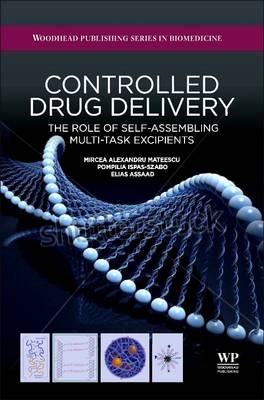
Controlled Drug Delivery
Woodhead Publishing Ltd (Verlag)
978-0-08-101574-2 (ISBN)
- Titel wird leider nicht erscheinen
- Artikel merken
Mircea Alexandru Mateescu is Professor of Biochemistry, Universite du Quebec a Montreal, Canada, and is a scientist with expertise in drug delivery systems and biochemical pharmacology. He is inventor of several novel biomaterials with particular characteristics related to supramolecular self-assembling phenomena and promoter of new technologies in pharmaceutical formulations. With more than 125 articles published in refereed specialty journals and 27 Patents, he is leading a large laboratory team. Mateescu is the holder of the J-A. Bombardier ACFAS Prize for Technological Innovation in Canada. Pompilia Ispas-Szabo is adjunct professor at Universite du Quebec a Montreal and Research & Development scientist in pharmaceutical industry. Her expertise relates to material science, formulation and characterization of drug delivery systems. With more than eighteen years' experience in the pharmaceutical field, Ispas-Szabo was deeply involved in the concept of novel polymeric excipients, drug delivery platforms and development of new products. Elias Assaad is Research Associate at the University of Quebec a Montreal, and has extensive experience in pharmaceutical research, particularly in the design of polymeric excipients for controlled drug delivery and in the conception of polyelectrolyte complexes. He is also skilled in the characterization of excipients for drug delivery systems.
List of figures
List of tables
Biography for book
1. The concept of self-assembling and the interactions involved
1.1 The concept of self-assembling
1.2 The nature of forces and types of interactions involved in self-assembly of macromolecules
1.3 Hydrogels and their role in drug conception and development
1.4 Self-assembling phenomena in solid dosage forms
1.5 Conclusions
References
2. Starch and derivatives as pharmaceutical excipients: From nature to pharmacy
2.1 General aspects
2.2 Structural considerations
2.3 Self-assembling in physically modified starches
2.4 Chemically modified starches and their self-assembling
References
3. Chitosan and its derivatives as self-assembled systems for drug delivery
Abbreviations
3.1 Introduction
3.2 Unmodified chitosan-self-assembled thermogels
3.3 Amphiphilic chitosan derivatives
3.4 Amphiphilic/amphoteric chitosan derivatives
3.5 Conclusion
References
4. Chitosan-based polyelectrolyte complexes as pharmaceutical excipients
Abbreviations
4.1 Introduction to chitosan-based polyelectrolyte complexes
4.2 Chitosan-chondroitin sulfate PEC
4.3 Chitosan-carboxymethyl starch PEC
4.4 Chitosan-dextran sulfate PEC
4.5 Chitosan-pectin PEC
4.6 Chitosan-alginate PEC
4.7 Chitosan complexed with other polysaccharides
4.8 Conclusion
References
5. Self-assembling in natural, synthetic, and hybrid materials with applications in controlled drug delivery
5.1 General considerations
5.2 Natural polysaccharides and their derivatives used in controlled drug release
5.3 Self-assembling of synthetic polymers
5.4 Hybrid materials obtained by self-assembling
5.5 Conclusions
References
6. Protein-protein associative interactions and their involvement in bioformulations
6.1 Introduction
6.2 Generalities on proteins, their roles, and their possible use as excipients
6.3 Albumin microspheres and nanoparticles for drug delivery
6.4 Self-assembling processes involving albumin and bioactive agents
6.5 Collagen: generalities and utilizations as material for biopharmaceutical applications
6.6 Protein excipients for solid dosage forms
6.7 Pharmaceutical solid, oral, high-loaded, and gastro-resistant dosage forms of therapeutic enzymes
6.8 Gastro-resistant excipient-free pharmaceutical forms of therapeutic enzymes
6.9 Conclusion
References
Index
| Erscheinungsdatum | 08.07.2016 |
|---|---|
| Reihe/Serie | Woodhead Publishing Series in Biomedicine |
| Verlagsort | Cambridge |
| Sprache | englisch |
| Maße | 156 x 234 mm |
| Themenwelt | Medizin / Pharmazie ► Medizinische Fachgebiete ► Pharmakologie / Pharmakotherapie |
| Medizin / Pharmazie ► Pharmazie | |
| Technik ► Umwelttechnik / Biotechnologie | |
| ISBN-10 | 0-08-101574-7 / 0081015747 |
| ISBN-13 | 978-0-08-101574-2 / 9780081015742 |
| Zustand | Neuware |
| Haben Sie eine Frage zum Produkt? |
aus dem Bereich


